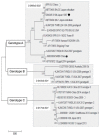Isolation of a Divergent Strain of Bovine Parainfluenza Virus Type 3 (BPIV3) Infecting Cattle in China
- PMID: 31146368
- PMCID: PMC6631270
- DOI: 10.3390/v11060489
Isolation of a Divergent Strain of Bovine Parainfluenza Virus Type 3 (BPIV3) Infecting Cattle in China
Abstract
Bovine parainfluenza virus type 3 (BPIV3) is one of the most important known viral respiratory pathogens of both young and adult cattle. It is also named "heat stress in transport", causing morbidity and mass death. New variants of BPIV3 have been detected or isolated in China since 2008. Here, we isolate one BPIV3 strain (named BPIV3 BJ) in Madin-Darby bovine kidney (MDBK) cells from nasal samples collected in China. Phylogenetic analysis showed that our isolate is related to BPIV3 of the genotype A. The comparison of BPIV3-BJ and the reference Chinese isolate NM09 showed that these strains are highly divergent. We found many differences in the amino acid composition in the nucleocapsid (NP) protein among these genotype A strains. Since the NP protein has been implicated in immunization studies, our BPIV3 isolate will be useful for the development of immune assays and vaccine studies. The diversity of BPIV3 lineages that we found in China indicated ongoing evolution for immune escape. Our study highlights the importance of genetic surveillance for determining the effect of BPIV3 variability on pathogen evolution and population-scale immunity.
Keywords: MDBK cells; biotechnology; bovine parainfluenza virus; cattle; phylogenetic analysis; vaccine.
Conflict of interest statement
The authors declare no conflict of interest. The funders had no role in the design of the study; in the collection, analyses, or interpretation of data; in the writing of the manuscript, or in the decision to publish the results.
Figures



Similar articles
-
Isolation and Identification of a Genotype C Bovine Parainfluenza Virus Type 3 and Its Pathogenicity in Albino Guinea Pigs.Transbound Emerg Dis. 2023 Nov 23;2023:8854528. doi: 10.1155/2023/8854528. eCollection 2023. Transbound Emerg Dis. 2023. PMID: 40303758 Free PMC article.
-
Isolation and genetic characterization of bovine parainfluenza virus type 3 from cattle in China.Vet Microbiol. 2011 May 5;149(3-4):446-51. doi: 10.1016/j.vetmic.2010.11.011. Epub 2010 Nov 13. Vet Microbiol. 2011. PMID: 21131145
-
Phylogenetic and antigenic analysis of bovine parainfluenza virus type 3 isolated in Japan between 2002 and 2019.Vet Microbiol. 2020 Aug;247:108774. doi: 10.1016/j.vetmic.2020.108774. Epub 2020 Jun 21. Vet Microbiol. 2020. PMID: 32768220
-
Review on bovine respiratory syncytial virus and bovine parainfluenza - usual suspects in bovine respiratory disease - a narrative review.BMC Vet Res. 2021 Jul 31;17(1):261. doi: 10.1186/s12917-021-02935-5. BMC Vet Res. 2021. PMID: 34332574 Free PMC article. Review.
-
Current status of vaccines for parainfluenza virus infections.Pediatr Infect Dis J. 2008 Oct;27(10 Suppl):S123-5. doi: 10.1097/INF.0b013e318168b76f. Pediatr Infect Dis J. 2008. PMID: 18820572 Review.
Cited by
-
Isolation, Identification, and Genetic Phylogenetic Analysis of Two Different Genotypes of Bovine Parainfluenza 3 Virus in China.Viruses. 2022 Oct 9;14(10):2221. doi: 10.3390/v14102221. Viruses. 2022. PMID: 36298776 Free PMC article.
-
Bovine Parainfluenza Virus Type 3 (BPIV3) Enters HeLa Cells via Clathrin-Mediated Endocytosis in a Cholesterol- and Dynamin-Dependent Manner.Viruses. 2021 May 31;13(6):1035. doi: 10.3390/v13061035. Viruses. 2021. PMID: 34072688 Free PMC article.
-
Isolation and Identification of a Genotype C Bovine Parainfluenza Virus Type 3 and Its Pathogenicity in Albino Guinea Pigs.Transbound Emerg Dis. 2023 Nov 23;2023:8854528. doi: 10.1155/2023/8854528. eCollection 2023. Transbound Emerg Dis. 2023. PMID: 40303758 Free PMC article.
-
Isolation and Genomic Characterization of a Chinese Genotype C Bovine Parainfluenza Virus Type 3 from Cattle and Its Pathogenicity in C57BL/6 Mice.Animals (Basel). 2024 Jan 31;14(3):463. doi: 10.3390/ani14030463. Animals (Basel). 2024. PMID: 38338106 Free PMC article.
-
Protective efficacy of a recombinant adenovirus expressing novel dual F and HN proteins of bovine parainfluenza virus type 3.Vet Res. 2024 Nov 7;55(1):144. doi: 10.1186/s13567-024-01400-z. Vet Res. 2024. PMID: 39511676 Free PMC article.
References
-
- Reisinger R.C., Heddleston K.L., Manthei C.A. A myxovirus (sf-4) associated with shipping fever of cattle. J. Am. Vet. Med. Assoc. 1959;135:147–152. - PubMed
-
- Fulton R.W., Blood K.S., Panciera R.J., Payton M.E., Ridpath J.F., Confer A.W., Saliki J.T., Burge L.T., Welsh R.D., Johnson B.J., et al. Lung pathology and infectious agents in fatal feedlot pneumonias and relationship with mortality, disease onset, and treatments. J. Vet. Diagn. Investig. 2009;21:464–477. doi: 10.1177/104063870902100407. - DOI - PubMed
-
- Hoerlein A.B., Mansfield M.E., Abinanti F.R., Huebner R.J. Studies of shipping fever of cattle. I. Para-influenza 3 virus antibodies in feeder calves. J. Am. Vet. Med. Assoc. 1959;135:153–160. - PubMed
-
- Murray G.M., More S.J., Sammin D., Casey M.J., McElroy M.C., O’Neill R.G., Byrne W.J., Earley B., Clegg T.A., Ball H., et al. Pathogens, patterns of pneumonia, and epidemiologic risk factors associated with respiratory disease in recently weaned cattle in ireland. J. Vet. Diagn. Investig. 2017;29:20–34. doi: 10.1177/1040638716674757. - DOI - PubMed
Publication types
MeSH terms
Substances
LinkOut - more resources
Full Text Sources
Miscellaneous

